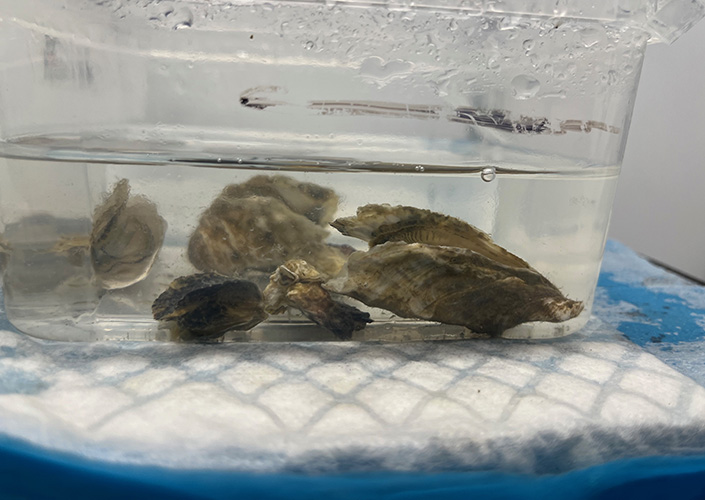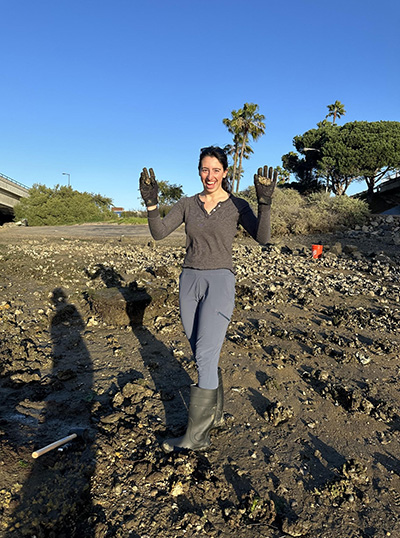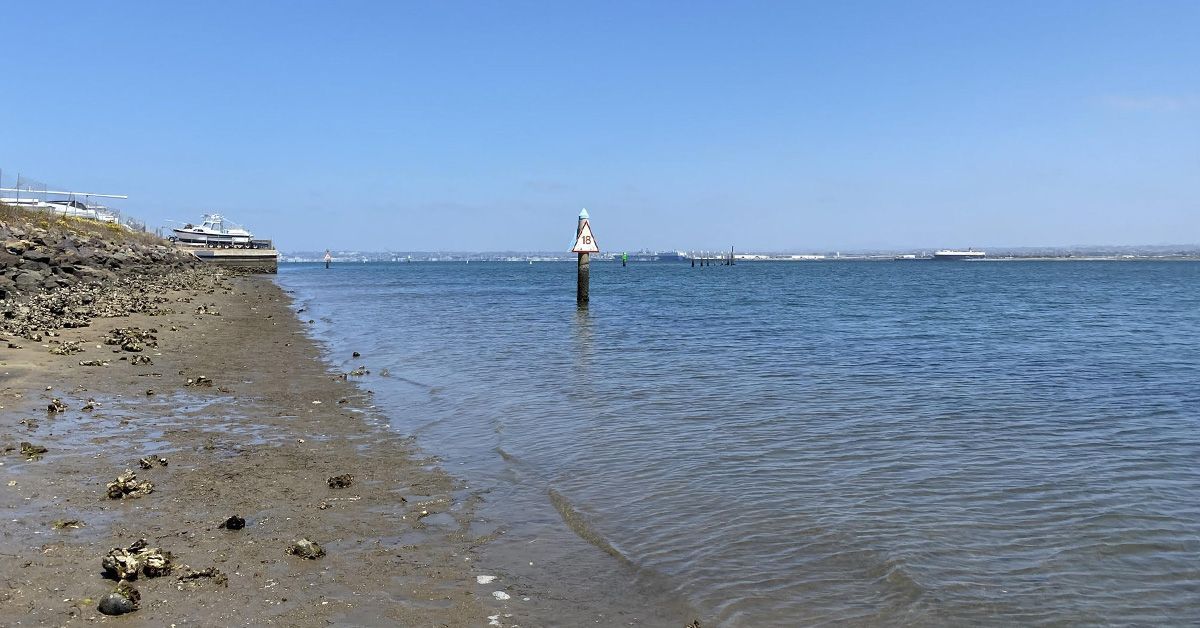Oyster Virus Detected in San Diego Bay Likely Worsened by Warmer Waters
Higher water temperatures accelerate spread of deadly virus, killing Pacific oysters and threatening aquaculture operations
Story by:
Published Date
Story by:
Topics covered:
Share This:
Article Content
New research led by scientists at UC San Diego’s Scripps Institution of Oceanography reveals how rising water temperatures influence a deadly herpes virus in juvenile Pacific oysters in San Diego Bay. While the ostreid herpesvirus (OsHV-1) does not pose a threat to humans, it is capable of causing mass mortality events among oysters, potentially hindering oyster aquaculture operations.
In a study published recently in the journal Sustainable Microbiology, a team of researchers in the Gilbert Lab at Scripps Oceanography identified that a San Diego microvariant of the OsHV-1 virus thrives above 15°C (59°F) and causes oyster mortality starting at 18°C (64°F).
The researchers conducted a series of lab-based experiments focused on the San Diego microvariant of OsHV-1 in Pacific oysters, finding that higher temperatures accelerate oyster deaths — particularly between 21-24°C (70-75°F). Once infected with the virus, the oysters had weakened defenses, leading to altered microbiomes and potential bacterial infections.
“Our study provides crucial insight into the relationship between rising water temperatures and the spread of a deadly virus that infects Pacific oysters,” said Emily Kunselman, lead author of the study and a recent PhD graduate of Scripps Oceanography. "We found that as the temperature increases, virulence also increases. In colder waters, these oysters appear to be protected from virus-induced mortality, but at higher water temperatures, the virus can cause mass mortality events and disrupt oyster farms.”
Kunselman said the team’s findings are important for managing OsHV-1 in oyster farms. As global ocean temperatures rise, the likelihood of OsHV-1-induced mortality outbreaks may also increase.
The recommended temperature threshold for farmed Pacific oysters is 20°C (68°F), general guidelines provided by the U.S. Department of Fish and Wildlife. This study is the first to specifically examine the San Diego Bay microvariant, confirming that the recommended threshold is reasonable.
OsHV-1 is a pathogen that plagues aquaculture industries around the world, particularly in France, Italy, Ireland, New Zealand, Australia, and along the West Coast of the United States. Microvariants of OsHV-1 are highly virulent and have led to mass mortality events on oyster farms.
During a heatwave in 2018, a microvariant of the virus was detected in San Diego Bay for the first time, impacting farmed triploid juvenile Pacific oysters (Crassostrea gigas) and leading to a 99% mortality rate. This event marked only the second time a virus like OsHV-1 had been documented in the United States. The same microvariant caused another mass mortality event in the bay in 2020, again impacting farmed oysters.
In San Diego Bay, water temperatures range from 15°C (59°F) in winter to more than 22°C (71.6°F) in summer, occasionally reaching as high as 25°C (77°F). During 2018, the first year OsHV-1 was detected, temperatures in the bay peaked at above 26°C (79°F).
The researchers aimed to pinpoint the temperature threshold of the OsHV-1 microvariant and examine its impact on the oysters’ microbial communities. In an experimental aquarium on the Scripps Oceanography campus, they set up a climate-controlled room with no flow-through seawater using biosecurity protocols approved by the California Department of Fish and Wildlife (CDFW). Different groups of Pacific oysters from a nursery in Humboldt Bay, Calif., were exposed to the San Diego Bay microvariant at four different temperatures: 15°C, 18°C, 21°C, and 24°C (59°F, 64°F, 70°F, and 75°F).
While the virus was able to replicate in oyster tissues at all temperatures, it did not cause mortality at 15°C (59°F), only at the higher temperatures. At temperatures above 21°C (70°F), the virus was shown to accelerate oyster deaths, killing them in a matter of days.
“Understanding temperature thresholds is critical for management of OsHV-1 both from a practical standpoint and also to better forecast future emergence of this virus to protect both wild and cultured shellfish in the state of California and beyond,” said study co-author Colleen Burge, a research scientist supervisor who leads the CDFW Shellfish Health Laboratory at the UC Davis Bodega Marine Laboratory. “This study importantly re-affirms that temperature is a driving factor in mortalities caused by OsHV-1.”
Additionally, the team discovered that microbes may play an important role in OsHV-1 infection. Using microbial sequencing, they examined the oysters’ bacterial response to the infection. The diversity of bacterial communities initially increased following exposure to the virus, but then decreased as the oysters became sick and died. Four dominant bacterial groups were identified, linking the San Diego microvariant with other microvariants globally.


In the experiment, some oyster groups were treated with antibiotics, while others were left untreated. The antibiotics had no noticeable impact on the oysters, highlighting the predominant role of heat in accelerating oyster deaths.
OsHV-1 has not been detected in wild oysters in San Diego Bay, leading researchers to suspect that these oysters may be tolerant of the virus, keeping viral levels below the limit of detection.
A single oyster nursery currently exists in San Diego Bay, and strict regulations govern the import, cultivation, and export of oysters in the bay. The current management strategy permits commercial harvest of oysters only in times when the temperature is below 20°C (68°F) coupled with weekly monitoring and immediate removal of infected stocks. Sentinel oysters remain for early detection of outbreaks.
Kunselman said further research on the OsHV-1 virus is needed to understand what causes it in the first place, and whether other oyster or shellfish species could be suitable candidates for aquaculture in San Diego Bay.
“The growth of aquaculture is essential to both food security and ocean sustainability,” said Kunselman. “Oysters are remarkable creatures that filter the water, keep things clean, and support thriving ecosystems. Our overarching goal is to support oyster aquaculture in San Diego through research on the OsHV-1 virus. By managing and mitigating some of the challenges presented in our study, there are opportunities to see aquaculture flourish.”
In addition to Kunselman and Burge, the study was co-authored by Sarah Allard and Jack Gilbert, who are both affiliated with Scripps Oceanography and the Department of Pediatrics at UC San Diego; Zachary Daniel from Scripps Oceanography; Daysi Manrique from Pomona College; Guillaume Mitta from IFREMER; and Bruno Petton from IFREMER and the University of Brest.
Funding for the study was provided by the American Malacological Society, the Conchologists of America, and the Western Society of Malacologists.
Learn more about research and education at UC San Diego in: Climate Change
Stay in the Know
Keep up with all the latest from UC San Diego. Subscribe to the newsletter today.




